Do Koi Fish Eat Algae? Understanding Their Natural Foraging Habits
This post may contain affiliate links.
Koi fish are a popular choice for ornamental ponds in the United States, admired for their vibrant colors and unique patterns. Many pond owners wonder if these beautiful creatures can help control algae growth naturally, a common challenge in maintaining a healthy pond ecosystem.
Understanding the natural diet and foraging behaviors of koi is crucial for effective pond management and ensuring optimal fish health. While koi are omnivorous, their relationship with algae is complex. This guide explores whether koi fish eat algae, what their natural diet consists of, and how to maintain balance in your pond.
Key Takeaways
- Koi fish can help control certain types of algae in ponds.
- Their omnivorous diet includes various aquatic plants and organisms.
- Understanding koi’s natural foraging habits is essential for pond management.
- Maintaining a balanced pond ecosystem is crucial for fish health.
- Supplemental feeding and algae control methods can be informed by koi’s natural diet.
The Relationship Between Koi Fish and Algae
The relationship between koi fish and algae is complex and multifaceted, influencing the overall health of the pond. Koi fish and algae coexist in a delicate balance that affects the pond’s ecosystem. To understand this relationship, it’s essential to explore whether koi fish actually eat algae and the different types of algae found in koi ponds.
Do Koi Fish Actually Eat Algae?
Koi fish do eat algae, but their consumption varies depending on the type of algae. While they may nibble on certain types, they don’t effectively control all forms of algae. For instance, koi may eat some string algae, but they rarely consume enough to control it. Understanding what koi eat helps pond owners manage algae growth.
Types of Algae Found in Koi Ponds
Koi ponds typically host several types of algae, each with different characteristics and impacts on pond health. Some common types include:
- String algae (filamentous algae) that appears as long green strands attached to rocks and pond edges.
- Planktonic algae that causes green water by suspending microscopic algae cells throughout the water column.
- Blanket weed, a form of filamentous algae that creates floating mats on the pond surface.
- Blue-green algae (cyanobacteria), which isn’t true algae but a bacteria that can produce toxins harmful to koi health.
- Brown algae (diatoms) that often appears as a slimy brown coating on surfaces.
Understanding these different algae types helps koi pond owners determine appropriate management strategies beyond relying on koi consumption. By recognizing the various forms of algae and their effects on the pond, owners can take steps to maintain a balanced ecosystem.
Understanding Koi Fish Natural Diet
The dietary needs of koi fish are complex and varied, reflecting their omnivorous nature. Koi fish have evolved to thrive in different environments, and their diet plays a crucial role in their adaptability.
What Koi Fish Eat in the Wild
In their natural habitat, koi fish feed on a variety of food sources. These include aquatic plants, insects, and small crustaceans. Their diet is not limited to algae; instead, they consume a broad range of materials, from plankton to detritus.
Koi fish are opportunistic feeders, meaning they eat what is available in their environment. This adaptability is key to their survival in the wild. In ponds, koi are often fed a diet that includes commercial pellets, but in the wild, they would forage for whatever is available.
Omnivorous Nature of Koi
Koi fish are true omnivores, capable of digesting both plant and animal matter. This is made possible by their unique digestive system, which lacks a stomach but features an elongated intestinal tract that continuously processes food.
Their omnivorous nature allows koi to thrive in various pond environments. Pond owners can capitalize on this by providing a varied diet that includes high-quality commercial foods, vegetables, and occasional treats like fruits.
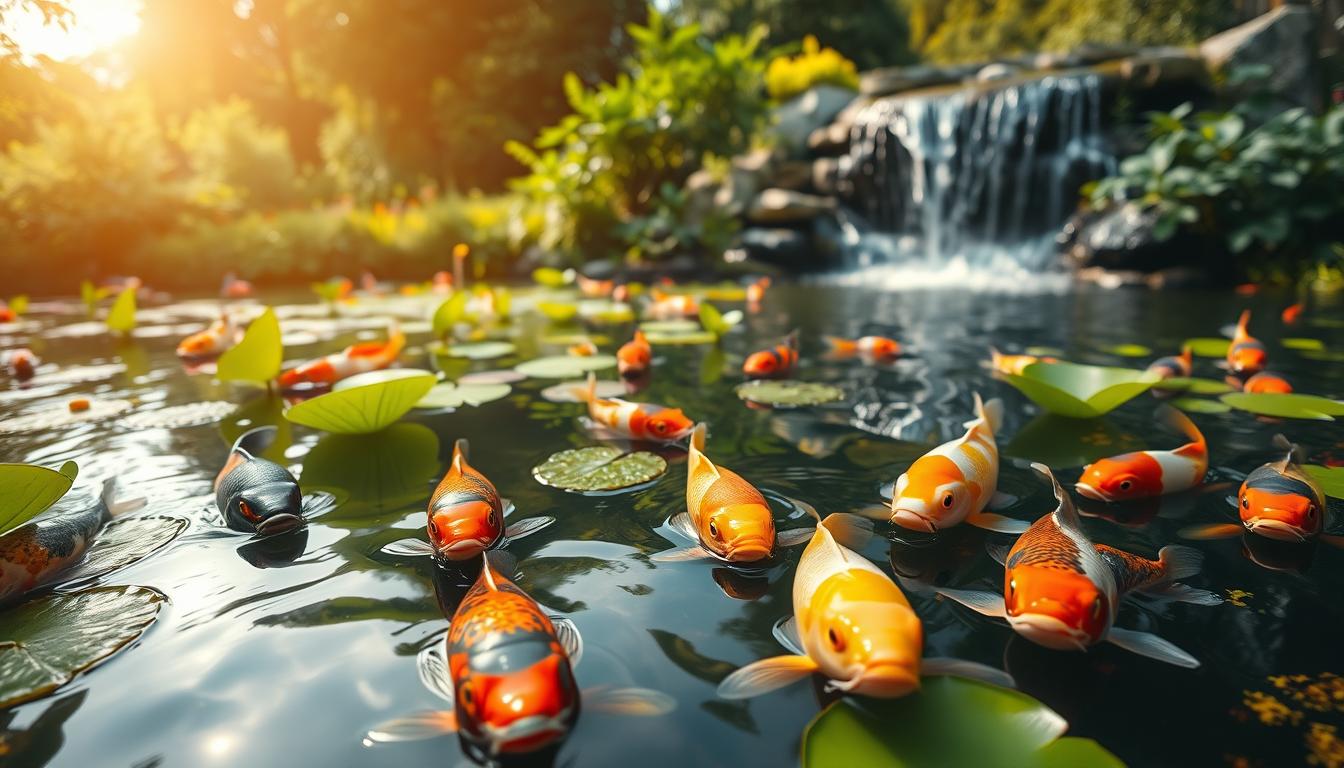
To better understand the dietary variety for koi fish, consider the following table that outlines common food options and their benefits:
| Food Type | Examples | Benefits |
|---|---|---|
| Commercial Foods | Koi pellets, flakes | Provides essential nutrients for growth and health |
| Vegetables | Blanched lettuce, spinach, peas | Offers variety and essential vitamins |
| Fruits | Melons, grapes | Can be used as occasional treats |
| Protein Sources | Insects, larvae | Important for growth, especially in young koi |
By understanding and catering to the omnivorous nature of koi, pond owners can ensure their fish remain healthy and thrive.
Koi Fish Foraging Behaviors
Understanding how koi fish forage for food provides insights into their nutritional needs and pond ecosystem dynamics. Koi fish are omnivorous, and their foraging behaviors reflect this dietary flexibility.
How Koi Search for Food
Koi fish are excellent foragers, using their senses to locate food in their environment. They employ a combination of visual and sensory cues to find edible items. When searching for food, koi use their protrusible mouth to explore their surroundings.
- Koi fish are naturally inclined to forage on the bottom of ponds, where they can find a variety of food sources.
- Their foraging behavior is influenced by their carp ancestry, which involved foraging in muddy lake and river bottoms.
Bottom-Feeding Habits
The bottom-feeding habits of koi fish are a crucial aspect of their foraging behavior. By sucking up substrate and sifting through it for edible items, koi help to remove debris from the pond floor.
- This behavior can sometimes stir up sediment, potentially increasing water turbidity, which highlights the importance of proper pond filtration.
- Pond owners can support this natural behavior by providing sinking pellets that allow koi to exercise their bottom-feeding instincts.
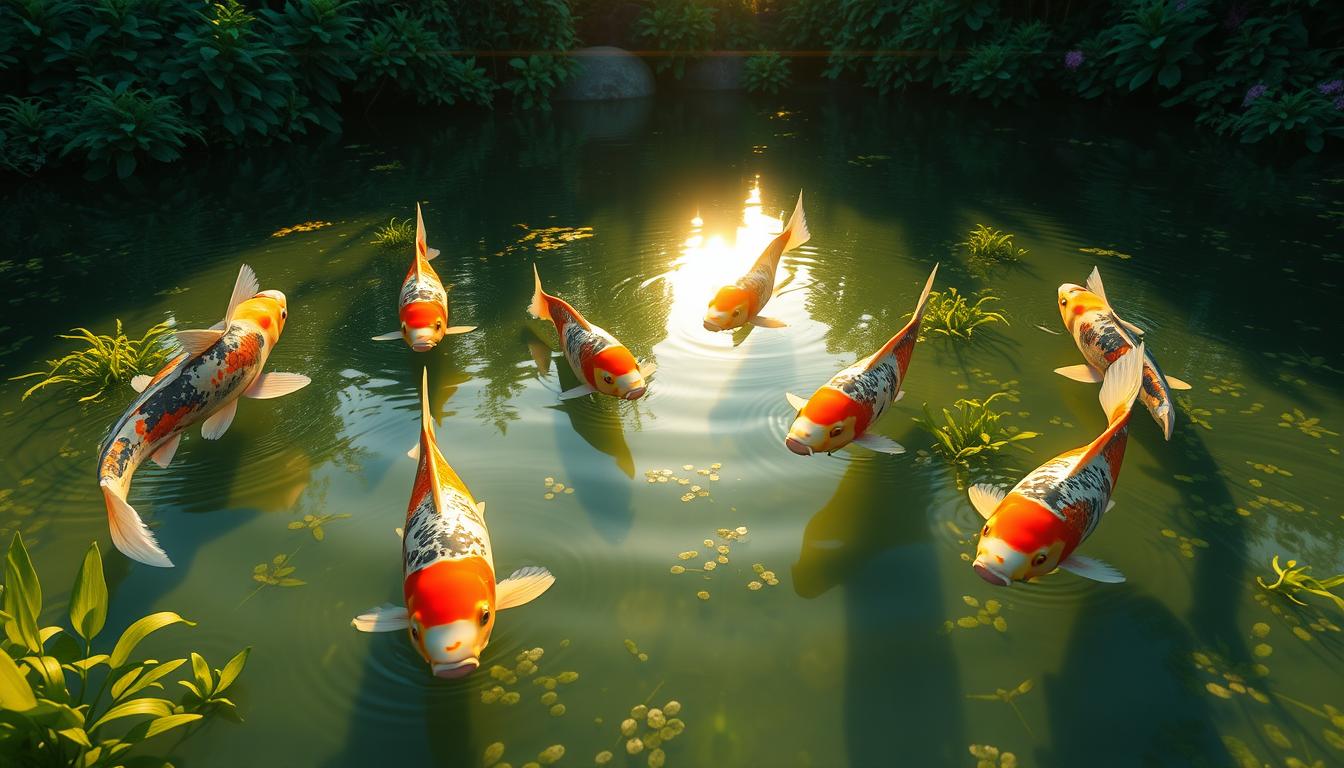
Algae Control in Koi Ponds
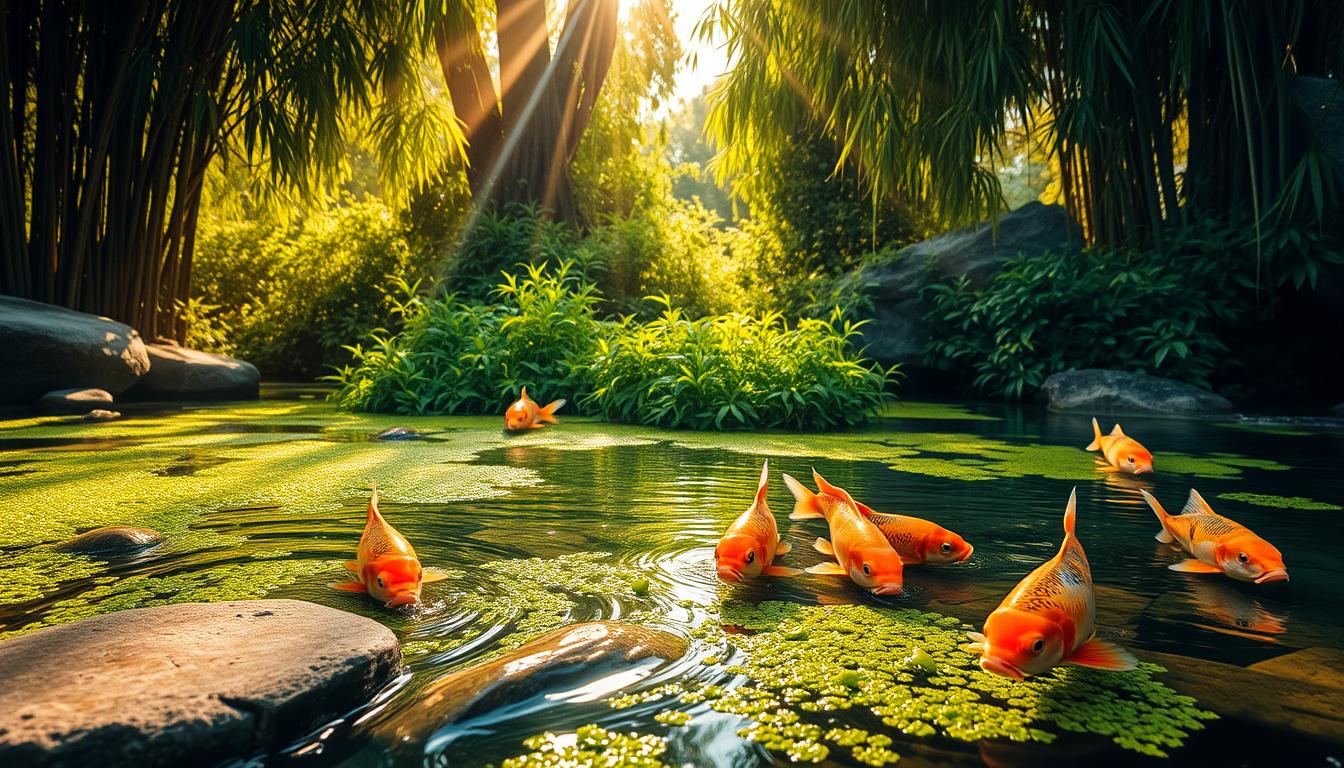
The presence of algae in koi ponds can be both beneficial and problematic, requiring careful management. Algae are a natural part of the aquatic ecosystem, but excessive growth can lead to water quality issues and negatively impact the health of your koi.
Beneficial vs. Problematic Algae
Not all algae are created equal; some types are beneficial, while others can be harmful. Beneficial algae help cycle nutrients and provide food for some aquatic life. However, when algae growth gets out of control, it can deplete the oxygen in the water, block sunlight, and even produce toxins harmful to koi and other aquatic organisms.
Identifying problematic algae is crucial. Types like string algae or blanket algae can quickly overgrow a pond, causing issues. On the other hand, some algae are harmless or even beneficial, contributing to the pond’s biodiversity.
Natural Algae Management Methods
Effective natural algae management in koi ponds starts with achieving proper biological balance. Several strategies can help manage algae growth without relying on chemical treatments.
- Incorporating floating aquatic plants like water lilies and lotus can shade the pond surface, reducing sunlight penetration that fuels algae growth.
- Submerged oxygenating plants such as anacharis and hornwort compete with algae for nutrients while providing additional oxygen to the water.
- Beneficial bacteria supplements can help break down organic waste that would otherwise feed algae blooms.
- A proper filtration system that includes mechanical, biological, and UV components works together to remove particles, process waste, and kill suspended algae cells.
- Maintaining appropriate fish stocking levels prevents excess waste production that can fuel algae growth.
- Strategic water changes (10-15% weekly) help dilute nutrients that accumulate and feed algae without disrupting the pond’s biological balance.
By understanding and implementing these natural management methods, pond owners can create an environment where algae remains at beneficial levels, complementing any minimal algae consumption by the koi themselves.
Proper Nutrition for Koi Fish
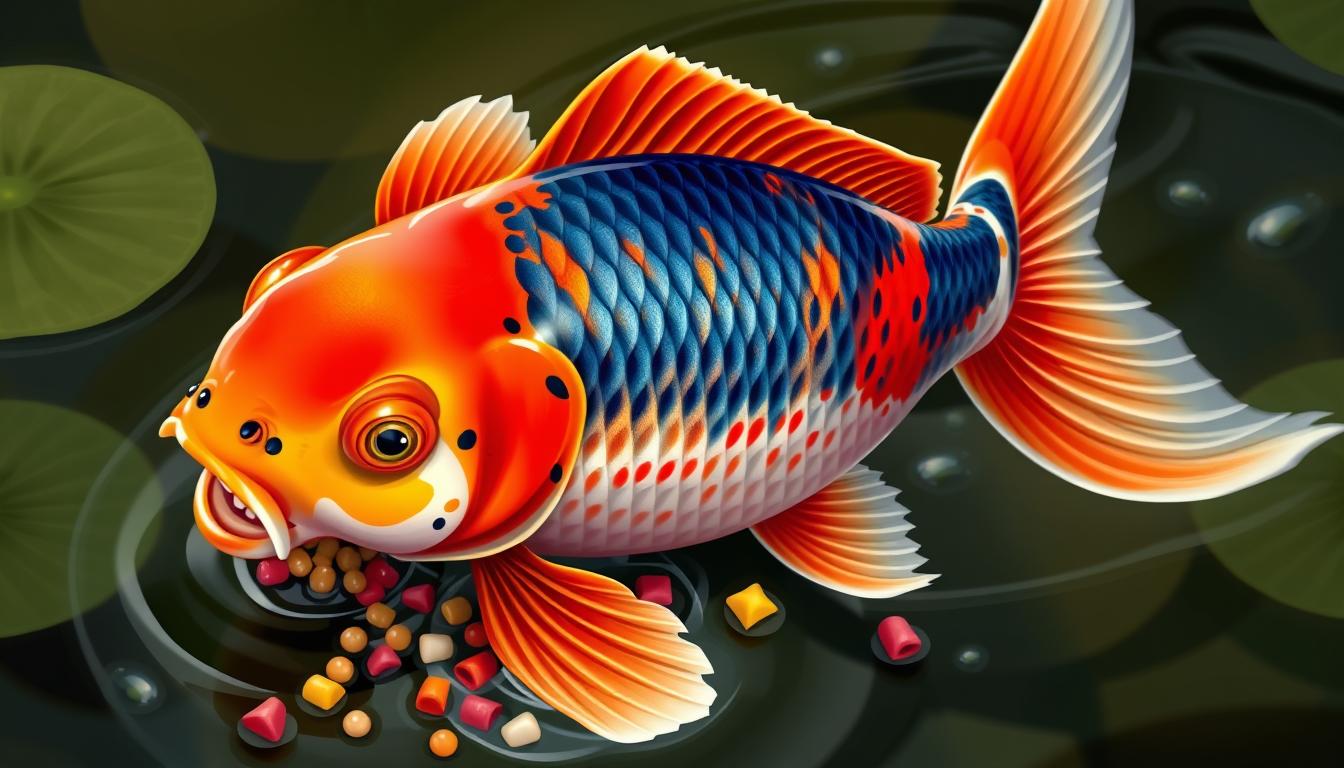
Proper nutrition is crucial for the health and well-being of koi fish. Feeding your koi is going to be your primary ongoing expense, with costs ranging between $50 and $200 per fish on food each month. A balanced diet is essential to support their growth, color, and overall health.
Commercial Koi Food Options
When it comes to feeding your koi, choosing the right commercial food is vital. High-quality koi food provides the necessary nutrients for optimal health. Look for foods that are specifically formulated to meet the nutritional needs of koi, and consider factors such as the fish’s age, size, and activity level.
Some key characteristics of good commercial koi food include a balanced mix of proteins, carbohydrates, and vitamins. Brands that use high-quality ingredients and have minimal fillers are preferable. It’s also important to vary the type of food you provide to ensure a broad spectrum of nutrients.
Supplementing Koi Diet
Beyond commercial foods, thoughtfully selected supplements can enhance koi nutrition, immune function, and color development. Fresh vegetables like lettuce, spinach, peas, and zucchini provide additional vitamins and fiber that support digestive health. Fruits such as oranges, watermelon, and berries can be offered sparingly due to their natural sugars and antioxidants.
Live or frozen foods, including bloodworms, brine shrimp, and daphnia, offer natural protein sources that stimulate natural foraging behaviors and can boost breeding condition. Best koi owners also use silkworm pupae as a high-protein supplement that contains natural color enhancers for red and orange pigmentation in koi fish.
Understanding these supplemental options helps create a varied diet that more closely mimics the diverse nutrition koi would access in natural settings. While koi may consume some algae during foraging, these intentional supplements provide far greater nutritional value.
Creating a Balanced Koi Pond Ecosystem
Balancing your koi pond’s ecosystem is vital to ensure the optimal health and vitality of your koi fish. A balanced ecosystem not only supports the well-being of your koi but also enhances the overall aesthetic and sustainability of your pond.
Plants That Complement Koi Ponds
Incorporating the right plants into your koi pond can significantly contribute to a balanced ecosystem. Aquatic plants help in maintaining water quality by absorbing excess nutrients that might otherwise fuel algae growth. Lily pads and water lilies are popular choices as they provide shade, reduce algae growth, and create a natural environment for koi. Other beneficial plants include Anacharis and Water Hyacinth, which help in maintaining water clarity and quality.
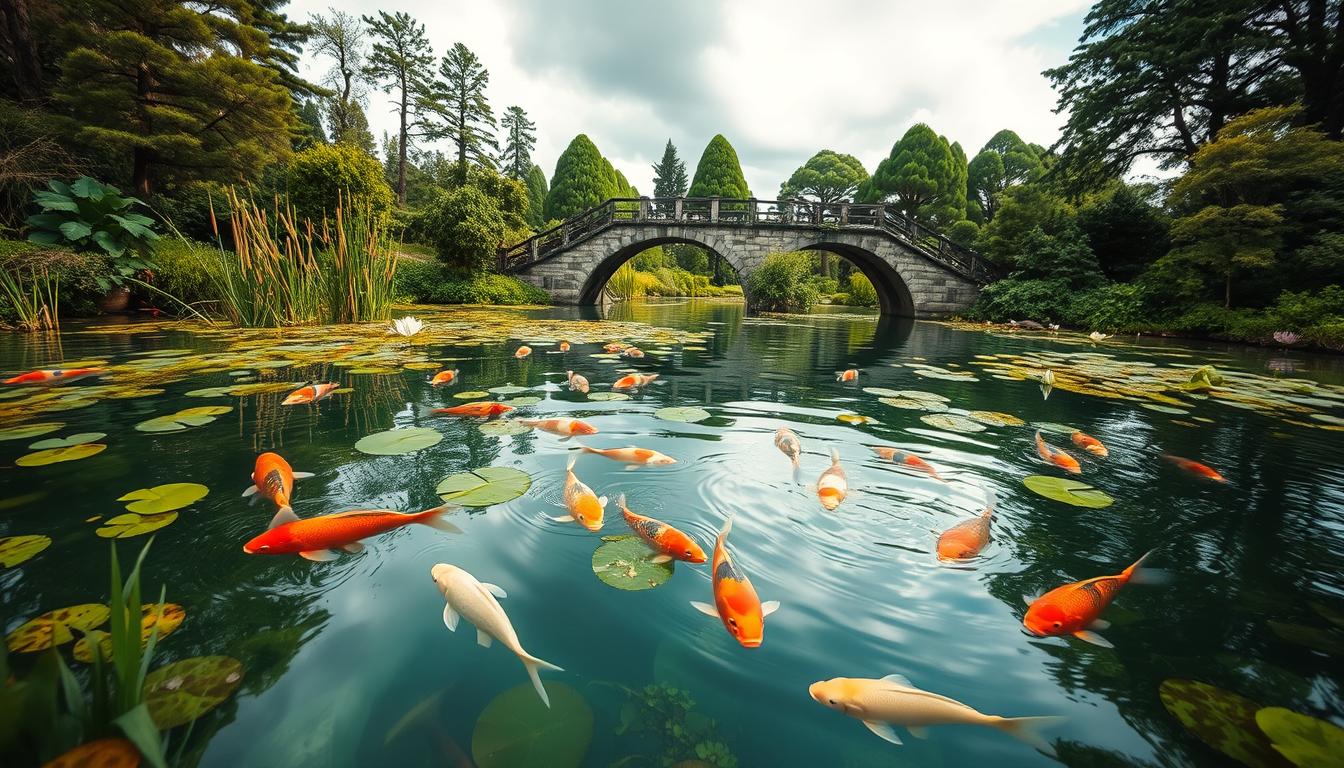
Beneficial Microorganisms
Beneficial microorganisms form the backbone of a healthy koi pond ecosystem. They process waste, help maintain water quality, and support the overall health of your koi. Nitrifying bacteria are particularly important as they convert toxic ammonia into nitrite and then into less harmful nitrate, completing the nitrogen cycle. Maintaining stable water conditions and avoiding harsh chemicals are crucial for supporting these beneficial microorganism populations.
- Nitrifying bacteria convert toxic ammonia into nitrite and then into less harmful nitrate.
- Beneficial protozoans and microcrustaceans consume suspended particles and algae cells, clarifying the water.
- Commercially available bacterial supplements can help establish or restore beneficial colonies.
| Microorganism Type | Function | Benefit to Koi Pond |
|---|---|---|
| Nitrifying Bacteria | Convert ammonia to nitrate | Reduces toxicity, supports nitrogen cycle |
| Beneficial Protozoans | Consume suspended particles | Clarifies water, improves visibility |
| Microcrustaceans | Consume algae cells | Reduces algae growth, improves water quality |
Varieties of Koi Fish
The world of koi fish is incredibly diverse, with numerous varieties captivating enthusiasts worldwide. Koi fish have been bred for centuries, resulting in a wide range of colors, patterns, and characteristics. This diversity has made koi keeping a fascinating hobby, with something for every level of enthusiast.
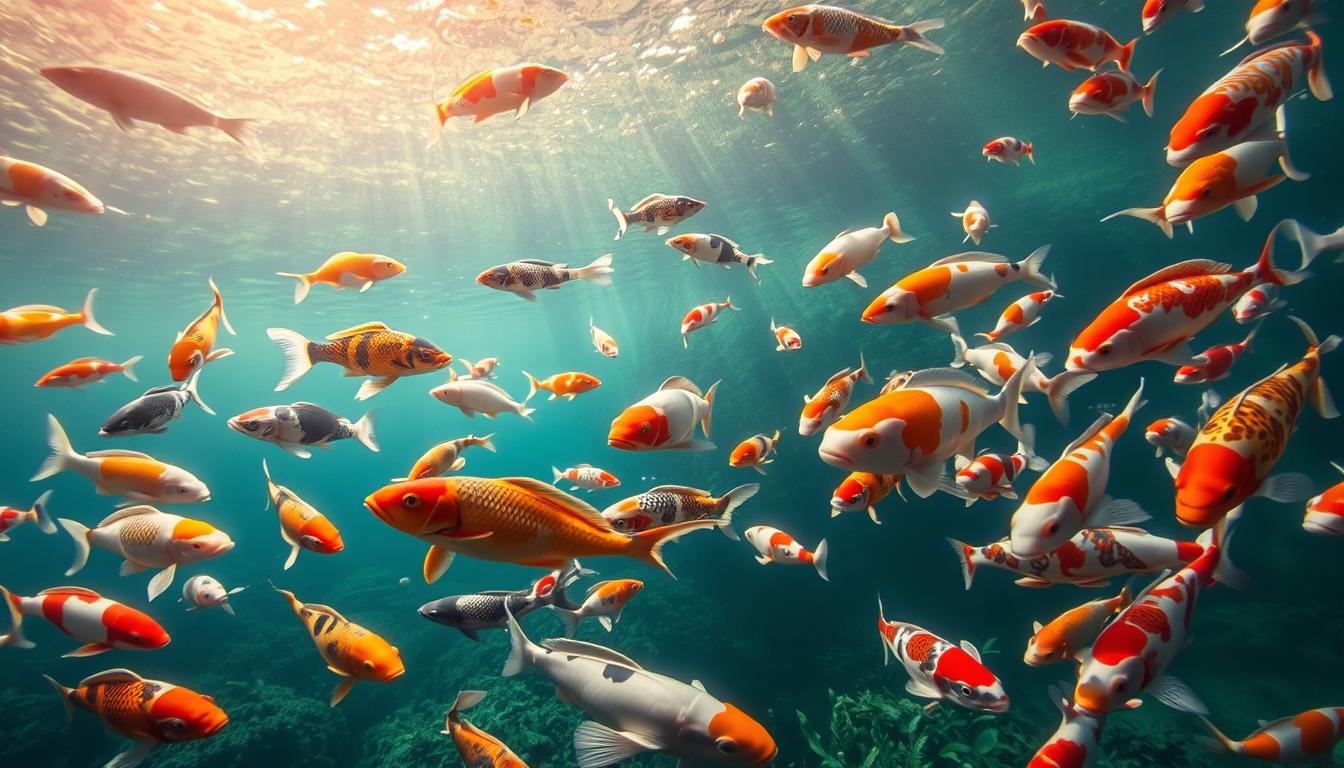
Popular Koi Varieties for Beginners
For those new to koi keeping, certain varieties are particularly popular and accessible. Kohaku, known for their white bodies with red markings, are a classic choice. Goshiki koi, with their multi-colored patterns, are also favored among beginners. These varieties are not only beautiful but also relatively easy to find and care for.
Another popular variety is the Tancho koi, recognized by the single red spot on their heads. This variety is prized for its simplicity and elegance. Beginners often find these varieties appealing due to their striking appearances and the symbolism associated with them.
Rare and Expensive Koi Varieties
The world of high-end koi collecting features rare varieties that can command extraordinary prices. Gin Rin varieties, with their sparkling scales, are highly valued. Kikokuryu koi, featuring metallic white bodies with dramatic black patterns, represent one of the newer premium varieties. These rare koi are often showcased in competitions and can fetch high prices due to their unique characteristics.
“S Legend, a Japanese Kohaku koi, is the most expensive koi fish ever—selling for $1.8 million in 2018 after winning Japan’s largest competitive exhibition for ornamental carp, the All Japan Nishikigoi Show.”
Other rare varieties include Beni Kumonryu, which change their pattern seasonally, making perfect specimens especially rare and valuable. The butterfly koi, while popular in the United States, are not as highly valued in traditional Japanese koi circles, where classic body shapes are preferred.
Setting Up a Koi Pond
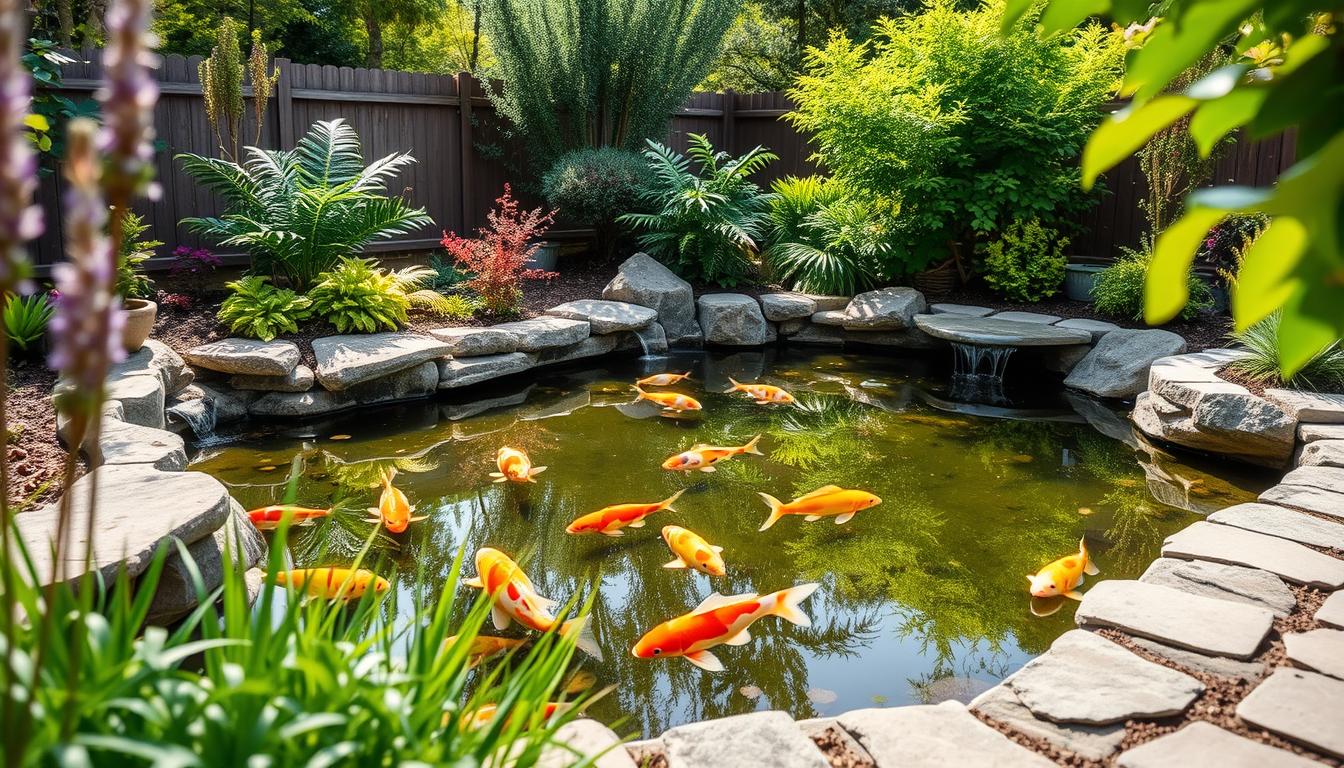
To keep koi healthy, it’s crucial to set up a pond that meets their specific needs. A well-designed koi pond not only enhances the aesthetic appeal of your garden but also provides a thriving environment for your koi.
Essential Equipment for Koi Ponds
When setting up a koi pond, having the right equipment is vital. This includes a reliable pump, a good filtration system, and adequate aeration to maintain water quality and oxygen levels. Proper equipment ensures the health and well-being of your koi by keeping the water clean and clear.
The quality of the equipment can significantly impact the overall health of your koi. Investing in high-quality pumps and filtration systems can help prevent water quality issues and reduce maintenance costs in the long run.
Ideal Pond Size and Depth
The size and depth of your koi pond are critical factors in creating a healthy environment for your koi. A common rule of thumb is to allow 1000 gallons of water for the first koi and 500 gallons for each additional koi. Aim for a minimum depth of 3-4 feet to allow for proper water temperature regulation and waste dilution.
Proper pond sizing is crucial for koi health. Inadequate space is one of the most common mistakes new koi keepers make. The minimum recommended pond size starts at 1,000 gallons, but serious enthusiasts often opt for 3,000+ gallon ponds. Depth is also important, with a minimum of 3 feet recommended for most climates and 4+ feet for regions with freezing winters.
Maintaining Water Quality for Healthy Koi
Maintaining optimal water quality is crucial for the health and well-being of koi fish in ponds. The quality of the water directly impacts the health, growth, and longevity of these beautiful creatures.
Water Parameters for Koi Health
To keep koi healthy, it’s essential to maintain optimal water parameters. This includes monitoring pH levels, ammonia, nitrite, and nitrate levels. The ideal pH range for koi is between 6.5 and 8.5. Regular water testing helps identify any imbalances, allowing for timely adjustments to maintain a healthy environment.
Filtration Systems for Koi Ponds
Effective filtration is the cornerstone of koi pond management. A properly designed filtration system handles the substantial bioload produced by these large, messy fish. Mechanical filtration captures physical debris, while biological filtration provides surface area for beneficial bacteria to colonize, converting toxic ammonia into less harmful compounds. High-surface-area media like bio-balls or lava rock maximize the efficiency of biological filtration. Additionally, UV sterilizers can supplement filtration by killing suspended algae cells and some pathogens, helping maintain water clarity and reducing disease risk.
By understanding and implementing effective filtration and water quality management strategies, koi keepers can create a thriving environment for their fish, ensuring their health and vitality.
Cost Considerations for Koi Fish Ownership
Koi fish ownership involves a range of costs, from the initial investment in the fish themselves to ongoing expenses for their care and maintenance. Understanding these costs is crucial for anyone considering bringing these beautiful creatures into their lives.
Initial Investment in Koi Fish
The initial cost of koi fish can vary significantly based on factors such as the size, quality, and variety of the fish. Expensive koi, often sourced from reputable koi farms, can command high prices. Additionally, setting up a koi pond requires a substantial initial investment in equipment such as pumps, filters, and aerators.
| Item | Cost Range |
|---|---|
| Koi Fish | $20-$1,000+ |
| Pond Equipment | $500-$2,000 |
| Total Initial Investment | $520-$3,000+ |
Ongoing Maintenance Costs
Ongoing maintenance represents the largest financial commitment in koi keeping. Feeding your koi is a primary ongoing expense, with quality koi food costing between $50 and $200 per fish per month. Utility expenses, including the cost to run electrical pond equipment and water fees, can range from $10 to $200 per month. Routine maintenance costs, such as replacement filter pads and water treatments, may add another $10 to $50 monthly.
If you choose to hire a professional service for pond maintenance, costs can range from $75 to $400 or more per month. Understanding these ongoing costs helps potential koi keepers budget realistically for the lifetime care of these long-lived fish.
Common Challenges in Koi Fish Care
Maintaining a thriving koi pond ecosystem is crucial, yet it poses several challenges for koi keepers. Koi fish require specific care, and understanding the common challenges is essential for providing the best environment for them to thrive.
Nutritional Health Issues
One of the primary challenges in koi fish care is related to their diet. Health issues can arise if their nutritional needs are not met. A poor diet can lead to various health problems, including swim bladder issues, digestive problems, and compromised immune systems. It’s crucial to provide a balanced diet that includes the necessary nutrients for optimal health.
As John H. on koi care once said,
“A well-balanced diet is the cornerstone of koi health.”
Ensuring that koi receive the right foods at the right time is vital for their well-being.
Seasonal Feeding Considerations
Seasonal adjustments are critical for koi feeding. The metabolism and nutritional needs of koi change with water temperature throughout the year. In the spring, feeding should begin gradually when water temperatures reach 50°F (10°C), starting with easily digestible foods. Summer is the primary growth period, with 3-4 daily feedings of higher-protein foods. In the fall, the diet should transition to lower-protein foods as temperatures drop, and feeding frequency should be reduced. Winter feeding should cease when water temperatures fall below 50°F (10°C) to prevent undigested food from causing health issues.
- Spring feeding: Gradually introduce wheat germ-based foods at 50°F (10°C).
- Summer feeding: 3-4 times daily with higher-protein foods between 65-85°F (18-29°C).
- Fall feeding: Transition to lower-protein foods and reduce feeding frequency below 65°F (18°C).
- Winter feeding: Cease feeding below 50°F (10°C).
Using a pond thermometer to guide feeding decisions rather than calendar dates helps account for regional climate differences and unusual weather patterns. Understanding these seasonal considerations helps koi keepers align their feeding practices with the natural biological rhythms of their fish, supporting optimal health throughout the year.
Compatible Tank Mates for Koi Fish
Koi fish can thrive in the company of other fish, provided you choose compatible species. The right tank mates can enhance the overall health and beauty of your koi pond. When selecting companions for your koi, it’s essential to consider factors such as size, temperament, and dietary needs.
Fish Species That Coexist Well with Koi
Several fish species can live harmoniously with koi. Goldfish, particularly larger varieties, make excellent companions as they share similar water quality requirements and are generally compatible in size and temperament. Shubunkin, a type of colorful goldfish, can add variety to your pond. Barbs are another option; they are active, hardy, and can hold their own against koi.
| Fish Species | Compatibility with Koi | Notable Characteristics |
|---|---|---|
| Goldfish (larger varieties) | High | Similar care requirements, peaceful nature |
| Shubunkin | High | Colorful, hardy, compatible size |
| Barbs | Moderate | Active, hardy, can be fin-nippers |
Algae-Eating Species to Complement Koi
In addition to koi, incorporating algae-eating species can help maintain a balanced pond ecosystem. Siamese algae eaters are effective against various algae types and remain relatively small. Common plecos can control algae on hard surfaces but require larger ponds due to their size and waste production. Freshwater snails like mystery snails and nerite snails are also beneficial, though they may require population management.
- Siamese algae eaters are effective against multiple algae types.
- Common plecos are suitable for large ponds.
- Freshwater snails help control algae without damaging plants.
Conclusion
As we conclude our exploration of koi fish and algae, it’s clear that their relationship is multifaceted. While koi do consume some algae during their natural foraging, they shouldn’t be relied upon as a primary algae control method in ornamental ponds.
Understanding the omnivorous nature of koi helps pond owners develop appropriate feeding strategies that support optimal health while complementing the fish‘s natural foraging behaviors. Creating a balanced pond ecosystem with appropriate filtration, plant life, and possibly dedicated algae-eating species provides more effective algae management.
The relationship between koi and algae is complex – some algae types provide ecological benefits, while others become problematic without proper management. Proper koi nutrition requires quality commercial foods and thoughtful supplements. Investing in quality koi from reputable koi farms is just the beginning of a commitment that includes ongoing care and regular maintenance.
Whether you’re keeping entry-level koi or investing in show-quality specimens from koi farms, the principles of good water quality, proper nutrition, and balanced ecosystem management remain the same. With proper care, koi can live 40-60 years, making them lifetime companions that reward the time and effort invested.
As you develop your skills in keeping koi, you’ll discover that these intelligent fish offer much more than just ornamental value. They become interactive pets that recognize their keepers and respond to their presence, making it much koi more than just a hobby. It’s a commitment to keep koi healthy and thriving.
